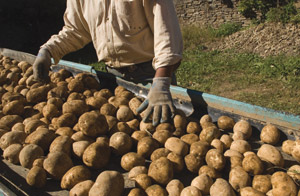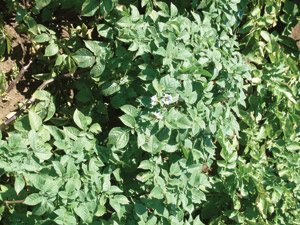
Features
Production
Research
Eye on Potatoes: Potato blight resistant potatoes coming soon
Potato blight resistant potatoes coming soon
October 3, 2008 By Eye on Potatoes
Dutch, British and American
scientists have developed a method to more quickly identify and isolate
genes that can be used to make potatoes resistant to Phytophthora
infestans, the dreaded potato blight.
Dutch, British and American scientists have developed a method to more quickly identify and isolate genes that can be used to make potatoes resistant to Phytophthora infestans, the dreaded potato blight.
With this method, multiple resistance genes from different species of potatoes can be isolated and possibly used simultaneously. This offers the prospect of achieving sustainable resistance against the pathogen because it is less capable of breaking the resistance of the potato when multiple genes are involved.
 Scientists have developed a method to more quickly identify and isolate genes that can be used to make potatoes resistant to Phytophthora infestans, potato blight. |
According to researchers at Wageningen University in the Netherlands, the Sainsbury Laboratory at the John Innes Centre in the U.K. and Ohio State University in the U.S., the best strategy to make potatoes resistant to Phytophthora is to develop so-called broad-spectrum resistance. In their article, published in the journal PLoS One, they explained that the current methods to discover resistance genes are too slow. Moreover, because they often concern only a single gene, these methods do not lead to sustainable resistance because Phytophthora can break single-gene resistance relatively quickly and easily.
The newly developed method is based on the interaction of genes of the pathogen and genes of the potato. The response of the potato involves resistance genes in the plant, and the response of P. infestans involves so-called avirulence genes. The avirulence gene produces proteins (effectors) that are recognized by the resistance gene proteins of the potato; an interaction then takes place.
By using effectors (proteins that are secreted by Phytophthora into the plant after infection takes place), researchers can relatively quickly identify and isolate the genes that are crucial to the interaction. Because the pathogen (Phytophthora) cannot switch off these proteins, but produces them constantly, genes that can recognize these proteins can potentially serve as resistance genes.
In the study, a set of 54 effectors (of an estimated 500 effectors in total) were tested on a large set of wild potato species. In many cases, this led to reactions from the wild potato species (the hypersensitivity response: the location where the effector protein was applied begins die off) and in one case to the actual identification of the effector protein – known as IPiO.

Since Phytophthora first ravaged the potato – an event epitomized by the Irish Potato Famine in the 19th century – this pathogen has been a permanent threat, and has repeatedly led to disastrous crop damage and high production costs.
|
This effector was found to be directly correlated with the resistance of three wild species, S. stoloniferum, S. papita and S. bulbocastanum. This means that a positive response against the effector always occurred in plants that had the resistance gene. In additional studies, the researchers were able to show that the effector in this case was the avirulence gene of the resistance gene. Because the researchers realized that the resistance genes from the three species had to be very similar, they were quickly able to isolate the resistance genes in S. papita and S. stoloniferum by using their knowledge of the previously isolated resistance gene from S. bulbocastanum.
Since Phytophthora first ravaged the potato – an event epitomized by the notorious Irish Potato Famine in the 19th century – this pathogen has been a permanent threat, and has repeatedly led to disastrous crop damage and high production costs. Until now, a very labour-intensive process of searching for sustainable resistance has yielded few or no results, and the use of fungicides has been essentially the only way to control the disease in modern agriculture.
The methods described in the article make it possible – relatively quickly – to acquire an impression of the prevalence and nature of resistance genes that would be very difficult or even impossible for the pathogen to break. By combining several of these potentially hard-to-break resistance genes, sustainable resistance will come within reach.
Print this page